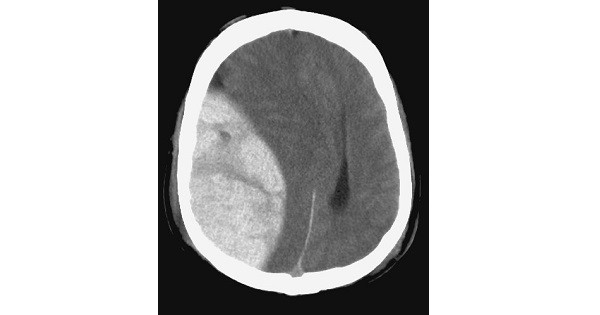Lucid Interval
Lucid Interval is seen in?
| A | Extradural hemorrhage | |
| B |
Subdural hemorrhage |
|
| C | Subarachnoid hemorrhage | |
| D |
All of these |
Lucid Interval is seen in?
| A | Extradural hemorrhage | |
| B |
Subdural hemorrhage |
|
| C | Subarachnoid hemorrhage | |
| D |
All of these |
Extradural hemorrhage REF: Bailey and love 25th edition page 303, Schwartz’s Principles of Surgery 9th edition chapter 42. Neurosurgery,
“The classical presentation of an EDH, occurring in less than one-third of cases, is initial injury followed by a lucid interval when the patient complains of a headache but is fully alert and orientated with no focal deficit. After minutes or hours a rapid deterioration occurs, with contralateral hemiparesis, reduced conscious level and ipsilateral pupillary dilatation as a result of brain compression and herniation”
Lucid interval is classically seen in:
| A |
Epidural hemorrhage |
|
| B |
Subdural hemorrhage |
|
| C |
Intraparenchymal hemorrhage |
|
| D |
None of the above |
Lucid interval is classically seen in:
| A |
Epidural hemorrhage |
|
| B |
Subdural hemorrhage |
|
| C |
Intraparenchymal hemorrhage |
|
| D |
None of the above |
Lucid interval is seen in :
| A |
Insanity |
|
| B |
Malignant disease |
|
| C |
Electrical shock |
|
| D |
Syphilis |
Lucid interval is seen in :
| A |
Insanity |
|
| B |
Malignant disease |
|
| C |
Electrical shock |
|
| D |
Syphilis |
A i.e. Insanity
‘Lucid Interval’ may be seen in:
| A |
Intracerebral haemorrhage |
|
| B |
Insanity |
|
| C |
Subdural haemorrhage |
|
| D |
Alcohol intake |
‘Lucid Interval’ may be seen in:
| A |
Intracerebral haemorrhage |
|
| B |
Insanity |
|
| C |
Subdural haemorrhage |
|
| D |
Alcohol intake |
B i.e. Insanity
Lucid interval is seen in –
| A |
Extra dural haemorrhage |
|
| B |
Intra dural haemorrhage |
|
| C |
Intra cerebral haemorrhage |
|
| D |
a and b |
Lucid interval is seen in –
| A |
Extra dural haemorrhage |
|
| B |
Intra dural haemorrhage |
|
| C |
Intra cerebral haemorrhage |
|
| D |
a and b |
Ans. is ‘a’ i.e. Extradural Haemorrhage, ‘b’ i.e. Intra dural haemorrhage
Lucid interval is a temporal sequence of events in which the patient has a period of normal functioning following head injury until symptoms (stupor, coma) begin.
Lucid interval is characteristic of epidural hematoma, but is also seen in subdural hematoma.
Lucid interval is classically seen in –
| A |
Intracerebral haematoma |
|
| B |
Acute subdural haematoma |
|
| C |
Chronic subdural haematoma |
|
| D |
Extradural haematoma |
Lucid interval is classically seen in –
| A |
Intracerebral haematoma |
|
| B |
Acute subdural haematoma |
|
| C |
Chronic subdural haematoma |
|
| D |
Extradural haematoma |
Ans. is ‘d’ i.e., Extradural haematoma
What is not found in head injury:
March 2007
| A |
Confusion |
|
| B |
Loss of consciousness |
|
| C |
Lucid interval |
|
| D |
GCS score of O |
What is not found in head injury:
March 2007
| A |
Confusion |
|
| B |
Loss of consciousness |
|
| C |
Lucid interval |
|
| D |
GCS score of O |
Ans. D: GCS score of O
Lucid interval is associated with:
September 2010, March 2013
| A |
Intracerebral hematoma |
|
| B |
Subarachnoid hematoma |
|
| C |
Extradural hematoma |
|
| D |
All of the above |
Lucid interval is associated with:
September 2010, March 2013
| A |
Intracerebral hematoma |
|
| B |
Subarachnoid hematoma |
|
| C |
Extradural hematoma |
|
| D |
All of the above |
Ans. C: Extradural hematoma
A lucid interval is a temporary improvement in a patient’s condition after a traumatic brain injury, after which the condition deteriorates.
A lucid interval is especially indicative of an epidural hematoma.
Lucid interval is classically seen in:
COMEDK 07; PGI 07; Kerala 08; WB 09; FMGE 10; DNB 10; NEET 13, 14
| A |
Intracerebral hematoma |
|
| B |
Acute subdural hematoma |
|
| C |
Chronic subdural hematoma |
|
| D |
Extradural hematoma |
Lucid interval is classically seen in:
COMEDK 07; PGI 07; Kerala 08; WB 09; FMGE 10; DNB 10; NEET 13, 14
| A |
Intracerebral hematoma |
|
| B |
Acute subdural hematoma |
|
| C |
Chronic subdural hematoma |
|
| D |
Extradural hematoma |
Ans. Extradural hematoma
Lucid interval may be seen in ‑
| A |
Intracerebral hemorrhage |
|
| B |
Alcohol intake |
|
| C |
Insanity |
|
| D |
Subdural hemorrhage |
Lucid interval may be seen in ‑
| A |
Intracerebral hemorrhage |
|
| B |
Alcohol intake |
|
| C |
Insanity |
|
| D |
Subdural hemorrhage |
Ans. is `e’ i.e., Insanity
Lucid interval is seen in insanity and epidural haemorrhage.
Lucid interval is a state of consciousness between two episodes of unconsciousness in subacute/chronic epidural haemorrhage. It is significant that during this period (lucid interval), the person can :
(i) Make a valid will, (ii) Can give valid evidence, and (iii) Is legally responsible for act done (civil/criminal).
Lucid interval is also seen in insanity, i.e. the period of sanity between two phases of insanity.


